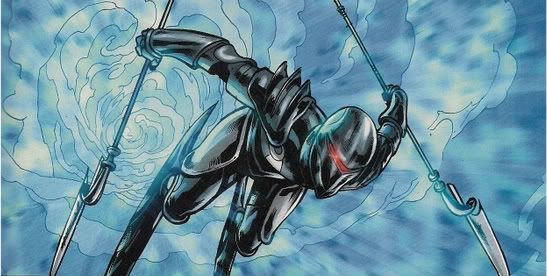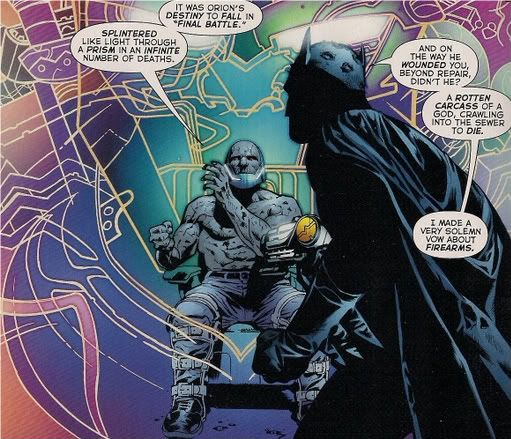You already know what happens, right?
/![]() Final Crisis #6 (of 7):
Final Crisis #6 (of 7):

Oh no, he's come for my interest in this series!
Hang on - let me run for a bit. Get that blood flowing. A little Speed Force never hurt! If there's one thing about this issue that really stands out to me, a Grant Morrison tragic, it's how the Doomsday Singularity and its accordant collapse of Earthly reality has resulted in a quantity of infinite Morrisons.
Look! The Atoms are shoving off on an emergency trip to a new reality not unlike the Atom 1,000,000 story in the old DC One Million 80-Page Giant, and the Marvel family is pulling off a depowering stunt not unlike that from the Black Adam climax of 52! You know about Batman this issue, right? His little throwdown with Darkseid evokes both The Invisibles and JLA: Rock of Ages, all while rolling around in Seven Soldiers references (visual and otherwise) and literally concluding Batman: R.I.P. - it's the heart of the storm, after all.
There's a great little joke(?) in that; if R.I.P. was a dark version of Morrison's All Star Superman, the shared-universe Gotham to a fabulously aloof Metropolis, then it's very fitting that Batman's *GASP* *CHOKE* violation of his twin vows against killing and discharging firearms outside of an authorized target range should recall the finale of a crucial All Star influence, Superman: Whatever Happened to the Man of Tomorrow?, in which what happened to the Man of Tomorrow was that he killed a reality-crushing threat and then had to scrub his confirmed capacity for murder away with fast-acting Gold Kryptonite. Morrison's Batman is darker to the end, shooting the essence of evil and dooming himself to a succession of hopeless lives-within-life.
Well, until he gets out. And he will - Morrison says so through a separate allusion: Darkseid's chamber as the Dark Side Club. Final Crisis itself has always functioned as something of a mirror image of Seven Soldiers -- transformed from a set of songs about superhero renewal to an all-out black alert of evil creativity remaking the world into shit and struggle -- so why not have Batman relive (and relive, and relive) Mister Miracle's run-in with the Omega Sanction? Shit, we know he's coming back now, because Mister Miracle is standing around elsewhere in the issue! His whole 'not really dying' thing was the last image of Seven Soldiers! You're wrong - Batman (and Robin) will never die!! It's Lex Luthor's stifled yawn at Final Crisis #1's roast of the Martian Manhunter on a cosmic scale, the enthusiastic shrug of Writers and Time Tailors midwifing the Fifth World from the stuff of innumerable alternate numbers.
Is that guy on the skis still behind me? Oops, shouldn't have lo

There's fundamental problems with Final Crisis #6. Mainly, it's sort of boring and the art isn't very good. It's probably a decent model of how a supercompressed comic can go wrong, devoting mannered attention to uninteresting plot devices while sapping the immediacy of the work's flow. Morrison, for his part, has already promised that the final issue will zip beyond supercompression into something that's "almost a new style." Channel-zapping comics, apparently fit for the televisions surrounding Nix Uotan’s head.
I hope that happens. I certainly thought the frenzied second half of last issue was as good as the series has ever been, with Morrison and his rapidly expanding art team really starting to cook all the DCU's clashy superhero concepts and their planet-spanning peril into a bubbling stew of absurd glee. To switch metaphors, it was very loud and very layered, and merrily discordant in the way a collage of diverse metahuman properties probably ought to be when thrown together by a dire threat. It's the patchwork coat of Seven Soldiers facing an especially tough wash cycle, one that threatens to soak out all the ill-fitting superhero style, all the idealism of the construct. Decadence! Anti-Life!
Unfortunately, this is neither last issue nor next issue, and it isn't terribly keen on universe-shattering metaphors rendered in broad genre strokes, or even much in the way of cacophonic style. In fact, it's the very picture of aesthetic conservatism in Event comics, a deeply formulaic plot-resolution-through-hitting piece, the kind of thing that settles on lining up the subplots and knocking them off with a minimum of fuss (if a maxiumum of space, since there's a lot of field to plow). It could have worked too, I guess, had the series been particularly effective at building up subplots in a traditional manner.
But earlier issues focused Morrison's density of content mainly on burbling, doomy mood, with dozens of flavors of corruption arriving to sour the good world, slowly. Superman's specific plight, for example, was never all that well-tuned as a plot point -- an explosion hits the Daily Planet juuust right, sending Lois Lane into a near-death state that only Clark's frequent attention can preserve, at which point he's whisked away to a tie-in -- but that didn't quite matter, because it mainly functioned as the concept of heroic self-sacrifice fading in luster as a distraction from endemic problems. And when Anti-Life struck, the results tossed the series and concepts into disarray, sometimes strikingly so.
Here, however, the series primarily hones in on specific resolutions to the conflicts facing specific groups of superheroes, few of which prove to be interesting. I imagine the Tattooed Man summoning the mark of Metron to his face in resistance to Anti-Life is supposed to be rousing, but there really hasn't been much done with his character save for a bog-standard redemption arc in a tie-in, to say nothing of the Green Arrow/Black Canary conflict, which leans entirely on the reader's preexisting investment in the characters for even the slightest resonance.
I mean, I'm 12 years old, so I laughed at Talky Tawny ripping a mean tiger's guts out and straightening his bow tie, sure, but the final fate of Bad Mary Marvel amounts to little more than Freddy Freeman puzzling out a (pretty obvious) means of depowering her, then goodness restoring itself via a decent pair of slacks. There's hardly any impact, partially because we're now up to six credited artists, some of which appear more rushed than others and none of which manage much panache in the midst of keeping the story information straight, but also because few of the subplots have to foundation to withstand the focus they're given. It all seems like a lot of flying around over nothing; pages filled up, maybe some pieces being put in place for future storylines.
It's not all dreary, no. Sometimes the flavor creeps though. I liked the first three pages a lot, a perfectly Morrisonian slice of silly high science synching up with superheroic wonder; the feeling it engenders manages to overcome the glaring absence of a pertinent tie-in issue, late in true Final Crisis fashion. These things have power. Style has power. Form. This issue seems so beholden to typical concerns, just far enough off from the series' poise to knock the whole thing down.
I wonder if it can get up? Maybe I can still escape the Black Racer. Maybe I'll think of Batman, and live by his example. Ah, but how am I supposed to embrace the poetic resonance of Bruce Wayne shooting a god with the very bullet that caused the series' first murder, the very kind of weapon that moved Batman to begin, when it's conveyed through a plot apparatus that requires all the legions of Darkseid to have somehow forgotten to check the Caped Crusader's utility belt for dangerous items in all the time he'd been held captive? Kind of a synecdoche for the whole series, that. What kind of asshole world conquerors are these?! Maybe the whole series is really a critique of governmental mismanagement? A little realistic. Let's get going to the next plane. EH.











